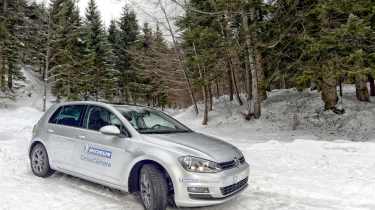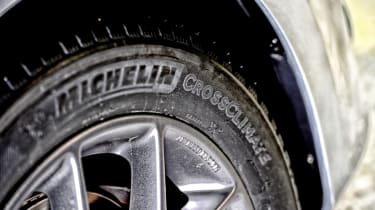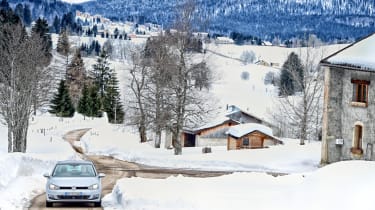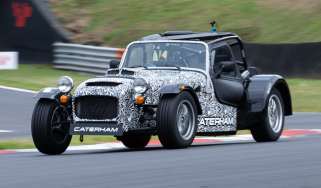Michelin Cross Climate vs Winter and All-season tyres
evo tests the world’s first summer tyre with winter certification on a ski slope
Michelin has made the bold decision to develop a summer tyre that can also work in winter. Called ‘Cross Climate’, the new tyre mixes the best of summer and winter tyre technology. And now, we've had the chance to test the tyre back-to-back against winter, all-season and summer rubber - on an indoor ski slope. But first, let's look over the Cross Climate.
Don’t be fooled into thinking this is another all-season tyre. Cross Climates are strictly labelled as summer rubber that borrow tread structure and compound chemistry from their winter counterparts. This enables them to receive official winter certification, so they can legally be used during winter in countries that enforce such tyre regulations.
Independent researcher Ipsos has concluded that a staggering 65 per cent of European motorists use summer tyres year-round, while 40 per cent believe switching between summer and winter rubber isn’t worth the effort. This undoubtedly compromises both performance and safety. And running all-seasons doesn’t solve the problem, because as we’ll find out shortly, conventional all-seasons fall short of the mark in several areas. Michelin claims Cross Climates don’t.
The tyre certainly looks good on paper. Compared with mid-spec Michelin winter rubber, braking distances shrink by a claimed 7.6 metres from 62mph. As much as 0.67 lateral G can be achieved during wet cornering too, just beating winter rubber (which one might expect to be more suited to the wet) by 0.01G. It’s also 0.05G more than mid-spec summer tyres can manage.
Should you fit winter tyres to your car - the test
Cross Climate vs Winter and All-season tyres
We joined tyre expert tyrereviews.co.uk for a test to compare the Cross Climate against two tyres from two other premium brands. The first was a full winter, the second was an all-season. Our venue? Tamworth Snowdome's ski slope, where the surface is dense snow and air temps hover around a crisp one degree Celsius. Burrrrr.
What do you do when equipped with three identical front-wheel-drive Skoda Octavia's and an empty ski slope? Have a race, of course. Starting at the bottom of the slope, all three cars were driven in a near identical manner - hold the throttle at the revs that over-speed the front wheels ever so slightly - and the results were, well, as expected. The full winter tyre maintained momentum best up the hill, allowing its driver to be quite aggressive with throttle inputs. The all-season was also able to reach the slope's peak, though its driver had to be slightly gentler with the accelerator - excessive wheelspin slowed progress.
And the Cross Climate? You might expect it to lag behind, given that it's the only tyre here with a summer focus. But no - the Cross Climate performed admirably and essentially matched the all-season (which only just trailed the full winter anyway) in each of our identical races.
The next test invovled braking from 15mph when coasting back down the hill. Without going into excessive detail, the results were rather similar - the winter stopped quickest, but this time, the all-season and Cross Climate were almost indistinguishable. And the same could be said when simulating a slalom course on the way up and down the hill. Once the snow's surface began to polish over, the Cross Climate and all-season fell further behind the winter tyre, but this is to be expected.
The test on our ski-slope confirmed that, in many ways, the Cross Climate can match a full all-season tyre. Of course, our test only really covered traction and braking, but we'll be pitting these same tyres against eachother - and a summer compound - on the road and track next. Look out for the results to that test in evo 217.
Video teaser
Dry and wet tests
We first sampled the Cross Climate on roads surrounding and on the French Alps earlier in the year. After equipping a Volkswagen Golf with Cross Climates, we were able to directly compare the tyre with conventional summer/winter/all-season in a series of controlled tests.
The first was wet braking. Braking from 62mph, we stopped some 5.3 metres shorter than conventional all-seasons could manage. Impressive.
The next test involved cornering on a wet road. While we didn’t have equipment to accurately measure lateral G fitted, the car was noticeably better at maintaining its line around corners than when wearing summer rubber. Understeer was significantly reduced on the Cross Climates.
The final test was to ascend a snow-covered ramp. While the Cross Climates couldn’t offer the bite of proper snow tyres, traction was mighty impressive if one used smooth, gentle throttle applications. In fact, the Cross Climates matched the all-seasons we tested. The summer rubber couldn’t even drag the car forward one-inch.
After the controlled tests, we sampled a Cross Climate-equipped Peugeot 308, also in the Alps. Conditions varied as we climbed higher, but the tyres remained secure and predictable throughout. Road noise was also better than conventional all-seasons, which sometimes have a tendency to drone at speed.
Technology
What is it that makes the Cross Climate such an effective all-rounder? Michelin claims the reasons lie in the tyre’s construction and tread. The former comprises two main layers: one makes up the outer tread, the second sits underneath and works to minimise heat transfer.
The tyre’s distinctive tread pattern features V-shaped blocks and self-blocking 3D sipes. The Vs optimise grip on snow, while also helping to improve lateral performance thanks to their widening widths. Sipes (hidden deep in the tread blocks) can boost traction by clawing through snow, but also improve braking performance by hunching together and firming up the tyre’s surface. Clever.
Key ratings include a European ‘A’ label for wet performance, ‘C’ for rolling resistance and one wave for external noise (the best available ranking). Winter certification is shown with the three-peak mountain snowflake symbol.
Price and sizes
Due to the complex technology within in the new Cross Climates, it was unsurprising to hear that they retail for 10 to 20 per cent more than standard summer rubber. A quick check on lovetyres.com reveals that the Cross Climate starts at £51.93, with sizes ranging from 185/55/R15 to 225/55/R17.







